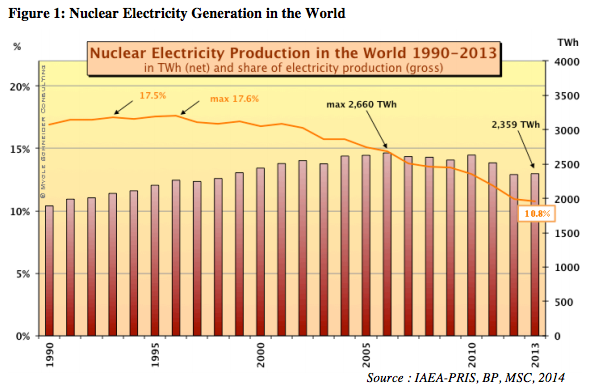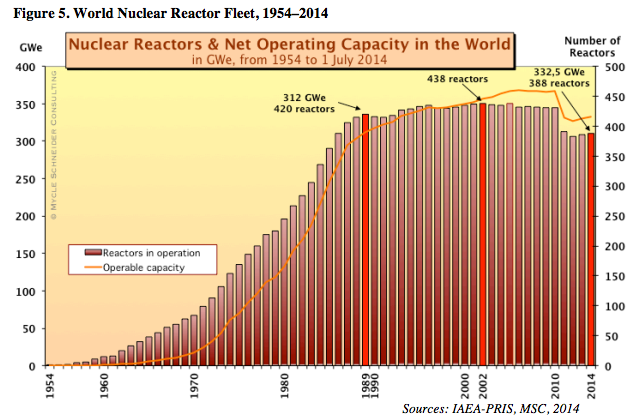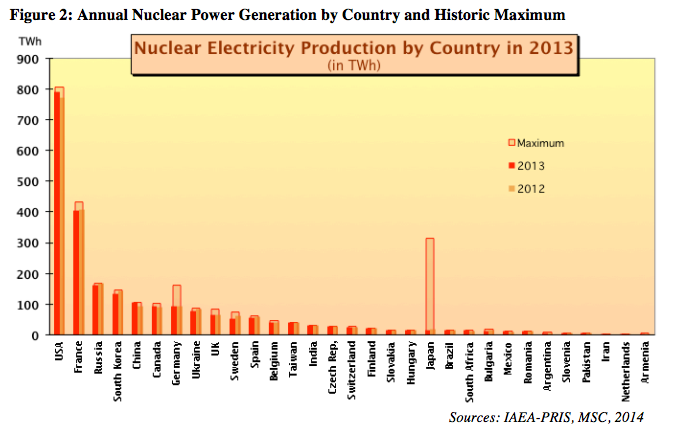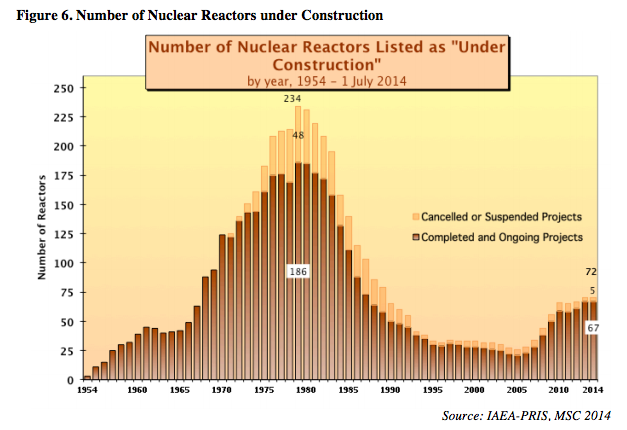nCa Commentary
It is expected that during that during his forthcoming visit to Uzbekistan, President Putin will participate in the groundbreaking ceremony of the first nuclear power plant of Central Asia.
According to the information available through the Uzbek and other media, the Russian company Rosatom will do the project in the Navoi region of Uzbekistan, near the Tudakul water reservoir.
Here are some details, as gleaned from various media reports:
- There will be two power units, with total capacity of 2300 megawatt. This will cover about 20% of the electricity requirements of Uzbekistan.
- The nuclear power plant will save up to 4 billion cubic meters of natural gas, which may create the potential of generating USD 600 million of annual revenues in the shape of export of natural gas.
- The atomic reactor would be of the Generation 3+ technology.
- The plant and structure would be able to withstand seismic vibrations up to 9 on the Richter scale.
- The plant will be located near the Tudakul reservoir, which is one of the main sources of fresh water in the Bukhara-Navoi regions.
- The Russian company Rosatom, which will build the plant, has 36 active nuclear energy projects in 12 countries, including Russia, China, Finland, Germany, India, and Iran, Bangladesh, Egypt, Jordan, and Turkey.
- The reactor type would be VVER (WWER – water-water energetic reactor), which was developed during the soviet times by the OKB Gidropress, and upgraded periodically.
- It will take 8-10 years to complete the plant.
- The offers of the Canadian and Chinese companies were also considered but Rosatom was selected because of its experience, technology and capacity.
- The negotiations between Russia and Uzbekistan started at the end of 2017 and went through various phases and stages before reaching the conclusion phase.
- During the construction stage, the nuclear power plant will provide jobs for 6000-10000 people. It will also help prepare the entire branch of nuclear engineering in Uzbekistan.
- The life of the reactors will be 60 years, extendable for another 20 years.
- The cost of the project is not disclosed but a similar station being built by Rosatom in Balgladesh carries the price tag of USD 13 billion.
* * *
There is the need to look at some aspects of nuclear energy.
The advancement in technologies for efficient and cheap alternative energies, and the risks and pitfalls associated with nuclear energy, have led to dampening of the appetite of the world for the nuclear power generation.
Some charts from an article written by Brad Plumer and published by Vox.com on 30 January 2015 will help explain the trend.




The complete article of Brad Plumer can be found here – https://www.vox.com/2014/8/1/5958943/nuclear-power-rise-fall-six-charts
Therefore, it is not surprising that the romance of the world with the nuclear energy was neither long lasting nor intense.
* * *
There is also the need to look at some myths associated with nuclear energy when compared to the renewable energy. In this, we can refer to the article of Mark Diesendorf, published by the Energy Post on 31 May 2016.
Here are some quotes from the article:
Myth 2: There is a renaissance in nuclear energy.
Global nuclear electricity production in terawatt-hours per year (TWh/y) peaked in 2006. The percentage contribution of nuclear energy to global electricity peaked at 17.5% in 1993 and declined to under 11% in 2014. Nowadays annual global investment in nuclear is exceeded by investment in each of wind and solar. Over the past decade the number of global start-ups of new nuclear power reactors has been approximately balanced by the number of closures of existing reactors. While several European countries are phasing out nuclear energy, most growth in nuclear reactor construction is occurring in China, Russia, India and South Korea. (World Nuclear Industry Status Report 2015)
Myth 3: Renewable energy is not ready to replace fossil fuels, and nuclear energy could fill the (alleged) gap in low-carbon energy supply.
Most existing nuclear power reactors are classified as Generation 2 and are widely regarded as obsolete. The current generations of new nuclear power stations are classified as Generation 3 and 3+. Only four Generation 3 reactors have operated, so far only in Japan, and their performance has been poor. No Generation 3+ reactor is operating, although two are under construction in Europe, four in the USA and several in China. All are behind schedule and over-budget – the incomplete European reactors are already triple their budgeted prices. Not one Generation 4 power reactor – e.g. fast breeder, integral fast reactor (IFR), small modular reactor – is commercially available. (World Nuclear Industry Status Report 2015) So it can be argued that modern nuclear energy is not ready.
On the other hand, wind and solar are both growing rapidly and are still becoming cheaper. Large wind and solar farms can be planned and built in 2-3 years (compared with 10-15 years for nuclear) and are ready now to replace fossil and nuclear electricity.
Myth 6: The problem of permanently storing high-level nuclear wastes has been solved.
All high-level waste is currently in temporary storage in pools or dry casks. Not one permanent repository is operating in the world. Development of the proposed US repository at Yucca Mountain in the USA was terminated after expenditure of $13.5 billion. Underground repositories are under construction in Sweden and Finland. Even if the technical and economic challenges could be solved, the social problem of managing or isolating the repositories for 100,000 years remains.
Myth 8: Nuclear energy emits no or negligible greenhouse gas emissions.
Neither nuclear energy nor most renewable technologies emit CO2 during operation. However, meaningful comparisons must compare whole life-cycles from mining the raw materials to managing the wastes. Nuclear physicist and nuclear supporter Manfred Lenzen found average life-cycle emissions for nuclear energy, based on mining high-grade uranium ore, of 60 grams of CO2 per kilowatt-hour (g/kWh), for wind of 10–20 g/kWh and for natural gas 500–600 g/kWh.
Now comes the part that most nuclear proponents try to ignore or misrepresent. The world has only a few decades of high-grade uranium ore reserves left. As the ore-grade inevitably declines, the fossil fuel used to mine (with diesel fuel) and mill uranium increases and so do the resulting greenhouse gas (GHG) emissions. Lenzen calculates that, when low-grade uranium ore is used, the life-cycle GHG emissions will increase to 131 g/kWh. Others have obtained higher levels. This is unacceptable in terms of climate science. Only if mining low-grade ore were done with renewable fuel, or if fast breeder reactors replaced burner reactors, could nuclear GHG emissions be kept to an acceptable level, but neither of these conditions is likely to be met for decades at least.
Myth 11: Renewable energies are more expensive than nuclear.
Variant: Nuclear energy receives smaller subsidies than renewable energy.
Both versions of the myth are false. Levelised costs of energy (LCOE) depend on the number of units installed at a site, location, capital cost, interest rate and capacity factor (actual average power output divided by rated power). LCOE estimates for nuclear are $108/MWh based on pre-2014 data from the IPCC and $97-132/MWh based on pre-2015 data from multinational financial consultants Lazard. The IPCC cost estimate does not include subsidies, while the Lazard estimate includes US federal government subsidies excluding loan guarantees and decommissioning.
None of these US estimates takes account of the huge escalation in costs of the two European Pressured Water Reactors (EPR) under construction (mentioned in Myth 3). The EPR proposed for the UK, Hinkley C, is being offered a guaranteed inflation-linked price for electricity over 35 years, commencing at £92.5/MWh (US$144/MWh) (2012 currency), more than double the wholesale price of electricity in the UK, together with a loan guarantee of originally £10 billion (US$15.3 billion). Its capped liability for accidents and inadequate insurance is likely to fall upon the British taxpayer.
In 2015 Lazard estimated unsubsidised costs for on-shore wind across the USA of US$32–77/MWh. An independent empirical study by US Department of Energy (Fig. 46) found levelised power purchase agreement prices in 2014 for wind in the US interior (region with the highest wind speeds) of US$22/MWh, and in the west (region with lowest wind speeds) about US$60/MW. The US government subsidises wind with a Production Tax Credit of US$23/MWh over 10 years, so this must be added to the DoE figures to obtain the actual costs. In Brazil in 2014, contracts were awarded at a reverse auction for an average unsubsidised clearing price of 129.3 real/MWh (US$41/MWh).
Lazard estimated unsubsidised costs of US$50–70/MWh for large-scale solar PV in a high insolation region of the USA. In New Mexico, USA, a Power Purchase Agreement for US$57.9/MWh has been signed for electricity from the Macho Springs 50 MW solar PV power station; federal and state subsidies bring the actual cost to around US$80–90/MWh depending on location. In Chile, Brazil and Uruguay,unsubsidised prices at reverse auctions are in the same range (Diesendorf 2016). Rooftop solar ‘behind the meter’ is competitive with retail grid electricity prices in many regions of the world with medium to high insolation, even where there are no feed-in tariffs.
In this article, Mark Diesendorf has argued powerfully that the nuclear energy is not free of environmental damage, is not cheaper than alternative energies, does not provide for flexible power-generation regimes, and the technologies can ultimately be used for nuclear weapons.
The complete article of Mark Diesendorf can be found here:
https://energypost.eu/renewable-energy-versus-nuclear-dispelling-myths/
* * *
There are also questions that are generated by commonsense.
For example, is it advisable to invest so heavily in the nuclear power plant with active life of at least 60 years when the technology is advancing so rapidly in the world? Will the plant not be obsolete long before it has given full value for its investment?
It is also pertinent to ask, what can be the rationale for spending four times the cost of the gas-powered electricity generation project of equal capacity?
Also important to ask is: What would be the disposal of the nuclear waste?
These are only some of the questions. The deeper we think, the more questions come to mind.
* * *
At another level, we are also mindful of the fact that Central Asia is striving to become a nuclear-free zone. For all intent and purpose, the project for nuclear power generation cannot be fully justified if we look at the entire range of arguments.
It will be in the interest of the brotherly feelings in the entire enighbourhood for Uzbekistan to take the region into confidence and explain the pros and cons that led to this decision.
<<<>>>